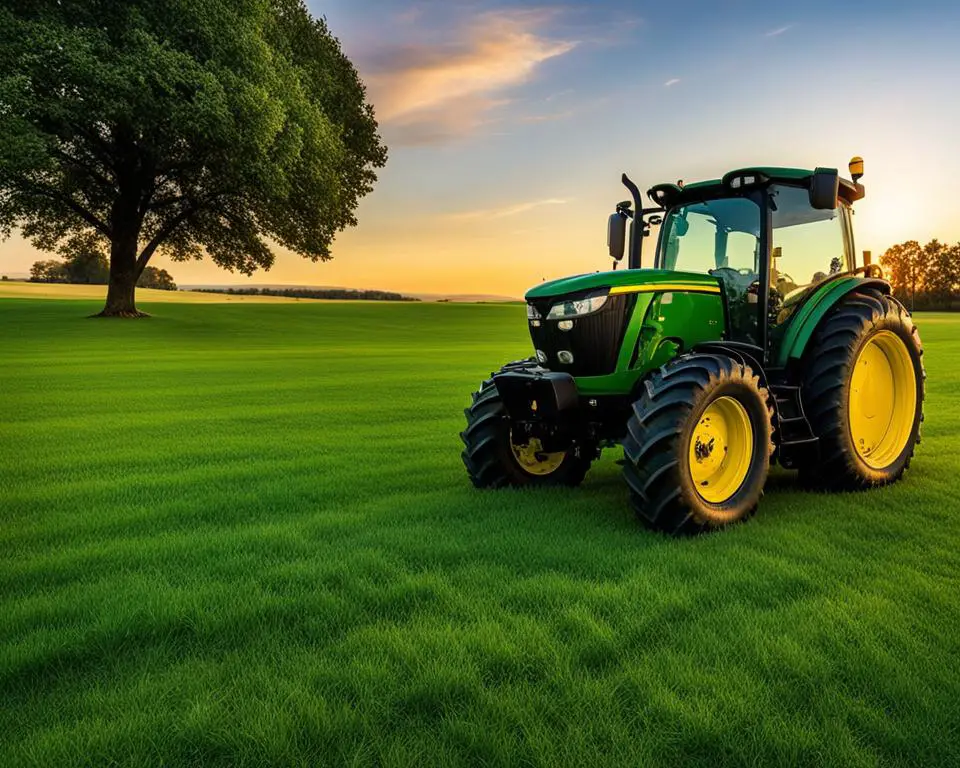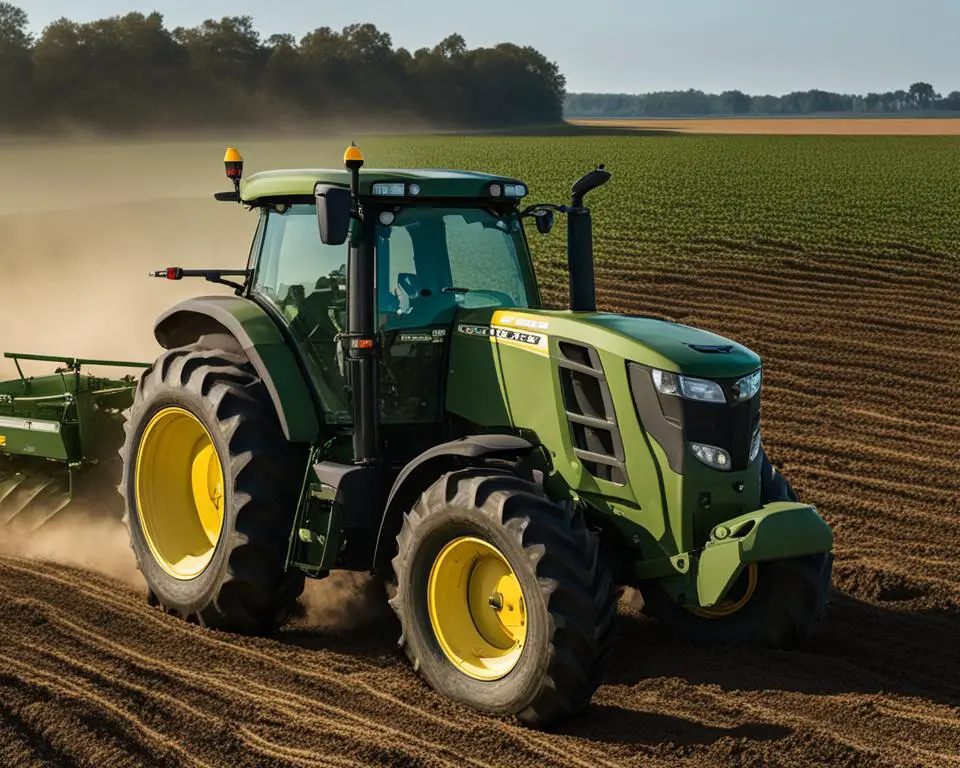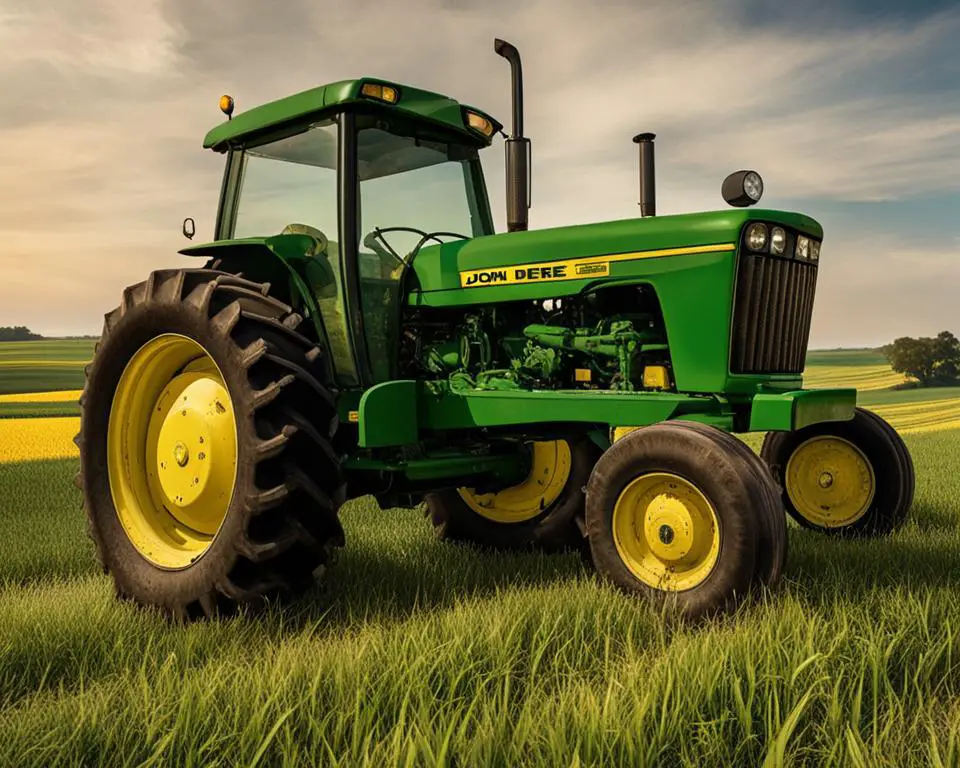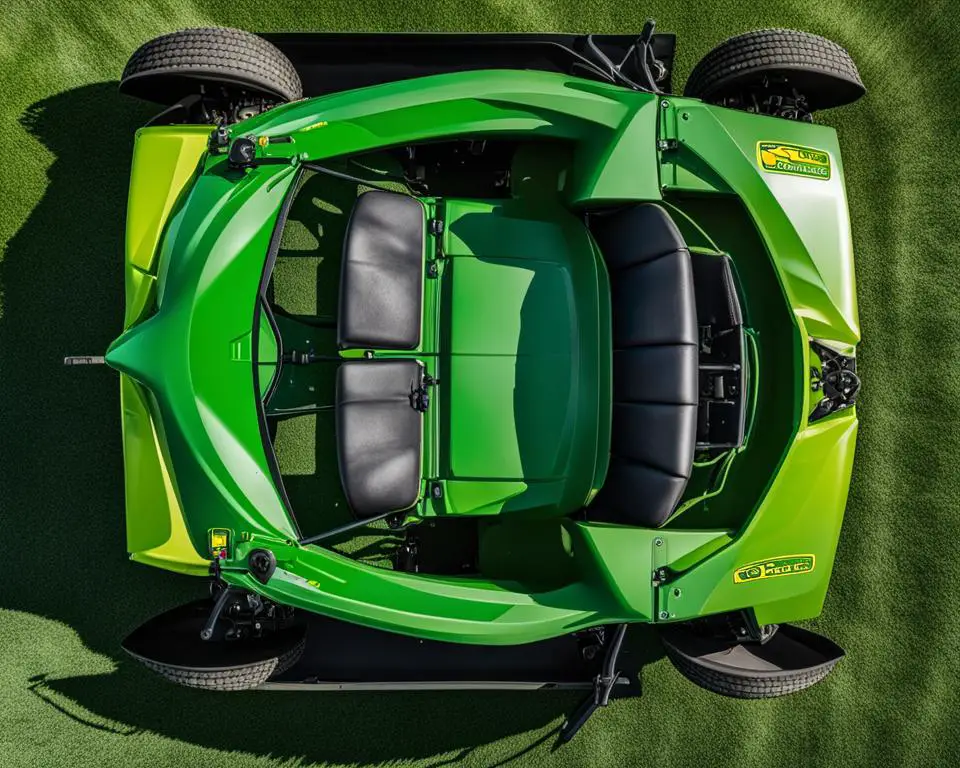When it comes to purchasing a new tractor, reliability is a key factor that every buyer considers. One brand that has stood the test of time is John Deere, known for its quality and durability. The John Deere 1010 tractor is no exception. With its impressive features and capabilities, it has gained a reputation as a reliable option for various tasks.
Before making a purchasing decision, it’s important to understand the strengths and potential drawbacks of the John Deere 1010. By examining its reliability, you can confidently assess whether it is the right tractor for your needs.
Throughout this article, we will explore the common problems that owners have encountered, the importance of mower deck setup and leveling, considerations when upgrading to a larger tractor, the design and functionality of utility tractors, and the drive shaft issues that the John Deere 1010 tractor may face.
Common Problems with the John Deere 1010 Tractor
The John Deere 1010 tractor is a reliable machine; however, like any piece of equipment, it can experience common problems that may affect its performance and operation. Being aware of these issues can help owners troubleshoot and take preventive measures to ensure the smooth functioning of their tractors. Here are some frequent problems reported by John Deere 1010 tractor owners:
1. PTO Lever Disengagement
One common issue with the John Deere 1010 tractor is the PTO (Power Take-Off) lever disengaging from its position, which can disrupt the operation of the mower deck. This problem can be resolved by making adjustments to the lever or using a small bungee cord to secure it in place, preventing it from dislodging during use.
2. Mower Deck Scalping
Another issue that owners may encounter is the mower deck scalping the grass, leading to an uneven cut. Proper leveling of the deck and using the correct blade height gauge are crucial for resolving this problem. Regularly changing the mowing direction can also prevent the grass from being knocked over in the same direction repeatedly.
| Common Problems | Solutions |
|---|---|
| PTO Lever Disengagement | Make adjustments to the lever or use a small bungee cord |
| Mower Deck Scalping | Ensure proper leveling and use the correct blade height gauge |
By addressing these common problems, owners can enhance the performance of their John Deere 1010 tractors and ensure efficient and effective operation. It is recommended to refer to the owner’s manual or consult a professional for specific troubleshooting instructions and guidance.
The Importance of Mower Deck Setup and Leveling
Proper setup and leveling of the mower deck is crucial for achieving a high-quality cut. The mower deck acts like a vacuum cleaner, lifting the grass with the suction created by the spinning blades. To optimize the grass cutting quality, it is recommended to use lift style blades with wings on the back side to maximize the air lift under the mower deck. These blades help stand up the grass and improve the cutting results.
When it comes to leveling the mower deck, following specific instructions is essential. Leveling ensures that the blades are parallel to the ground and at the correct height, resulting in an even cut. A deck blade height gauge comes in handy for accurate adjustments and maintaining consistent cutting height.
Here are some crucial steps for setting up and leveling your mower deck:
- Start by parking the tractor on a level surface.
- Lower the deck to the lowest cutting height.
- Measure the cutting height using a deck blade height gauge and adjust if necessary.
- Inspect the deck for any signs of damage or wear and replace any worn or damaged parts.
- Check the deck belt tension and adjust if needed.
- Ensure that all deck hanger brackets are properly attached and aligned.
- Tighten all nuts and bolts on the deck to prevent vibrations and loosening during operation.
Following these steps will help you achieve an optimal setup and level the mower deck, resulting in improved grass cutting quality and a more visually appealing lawn.
Benefits of Lift Style Blades
Lift style blades with wings on the back side provide several benefits for grass cutting quality. These blades create increased air lift under the mower deck, promoting a more even cut by lifting the grass upright before cutting. Here are some advantages of using lift style blades:
- Better Grass Stand: The wings on the back of the blades help lift the grass, reducing the risk of it being pushed flat by the mower deck.
- Improved Cutting Results: The increased air lift allows the blades to make cleaner cuts, resulting in a more professional-looking lawn.
- Reduced Scalping: Properly set up lift style blades can minimize the risk of scalping, where the mower deck cuts too low and leaves uneven patches in the grass.
Overall, using lift style blades with wings can significantly enhance the performance and cutting quality of your mower deck.
| Lift Style Blades vs. Conventional Blades | Lift Style Blades | Conventional Blades |
|---|---|---|
| Grass Stand | Upright, minimal flattening | Risk of flat grass |
| Cutting Results | Cleaner, professional-looking | Less precise, rougher edges |
| Scalping | Minimized risk | Potential for uneven cutting |
Considerations for Upgrading to a Larger Tractor
Thinking of upgrading to a larger tractor to improve your mower quality? While it may seem like a tempting solution, there are a few factors to consider before making the leap.
One important consideration is the potential impact on your lawn. Larger tractors are heavier and can create impressions on the grass, leading to uneven terrain and difficulties in achieving a high-quality cut. These impressions can be especially noticeable on lawns with soft soil or delicate grass varieties.
Another aspect to keep in mind is the type of mower you currently use. Commercial zero-turn mowers, known for their deep fabricated mower decks and higher blade tip speeds, are considered the gold standard for achieving immaculate cutting results on residential lawns. These technologically advanced machines provide superior maneuverability and precision, ensuring a pristine lawn appearance.

However, if you already own a John Deere 1010 tractor, rest assured that it can still deliver satisfactory mowing performance with the right adjustments and maintenance. By following proper mowing practices and performing regular maintenance tasks, such as sharpening the blades and checking the mower deck alignment, you can enhance the cutting quality of your John Deere 1010.
Ultimately, the decision to upgrade to a larger tractor or stick with your current equipment depends on your specific needs and preferences. If you prioritize the highest quality cut and don’t mind the investment, a commercial zero-turn mower might be the ideal choice. On the other hand, if you are content with satisfactory results and value the versatility of your John Deere 1010 tractor for other tasks, upgrading may not be necessary.
The Design and Functionality of Utility Tractors
Utility tractors, such as the John Deere 1010, offer versatility for various tasks but come with some compromises. The design of utility tractors includes features like drive over decks or easily removable mower decks, which may result in less air volume and lift for cutting grass. These compromises allow utility tractors to perform a wide range of functions, such as digging with a front-end loader or backhoe. However, for dedicated mowing tasks, commercial zero-turn mowers are still the superior choice.

Despite their versatility, utility tractors like the John Deere 1010 may not provide the same cutting performance as specialized mowers. The focus of utility tractors is on their multipurpose capabilities, allowing users to tackle various tasks around the yard or worksite. The drive over or removable mower decks prioritize convenience and ease of transition between different attachments, which may compromise the air volume and lift required for optimal grass cutting quality.
However, utility tractors truly shine when it comes to tasks beyond mowing. With a front-end loader or backhoe attachment, they can handle heavy lifting, digging, and loading operations that go beyond the capabilities of commercial zero-turn mowers.
Comparing Utility Tractors with Commercial Zero-Turn Mowers
When comparing utility tractors and commercial zero-turn mowers, it’s important to consider the specific requirements of your lawn care or landscaping needs. Here is a breakdown of the key differences:
| Utility Tractors | Commercial Zero-Turn Mowers | |
|---|---|---|
| Primary Function | Versatility for various tasks | Dedicated, professional-grade mowing |
| Mowing Performance | Compromised by drive over/removable decks | Optimized for superior cutting results |
| Additional Functions | Can handle other attachments (loader, backhoe) | Focused exclusively on mowing functionality |
| Maneuverability | Less agile, wider turning radius | Exceptional agility with zero-turn capability |
| Size | Larger, bulkier machines | Smaller, compact machines |
| Cost | Generally more affordable | Higher price point for professional-grade models |
Ultimately, the choice between a utility tractor and a commercial zero-turn mower depends on the specific tasks you need to accomplish. If you require a versatile machine that can handle various attachments and tasks, a utility tractor like the John Deere 1010 is a reliable option. However, if achieving the highest quality mowing results is your primary concern, a commercial zero-turn mower offers the cutting performance and maneuverability needed for pristine lawns.
Drive Shaft Issues in the John Deere 1010 Tractor
Some owners of the John Deere 1010 tractor have reported encountering drive shaft problems, specifically with the u-joints. These failures can lead to snapped drive shafts and significant repair expenses.
It has been observed that the u-joints in the drive shaft are sealed and unserviceable, which may indicate a design flaw. In order to avoid such issues in the future, aftermarket u-joints with more accessible grease fittings, such as the MOOG UJ410, have been recommended as alternatives.
If you are experiencing drive shaft issues with your John Deere 1010 tractor, it is advisable to consult reputable auto shops or tractor repair shops. They can provide expert advice on u-joint replacements and help you address the problem effectively.

When dealing with drive shaft repairs, there are several tips and tricks that can make the process easier:
- It is recommended to remove the floor shield to have better access to the rear u-joint, which can potentially be greased with a smaller fitting if it hasn’t completely failed.
- The front of the drive shaft can be accessed through the removable access panel on the right side, making it more convenient to work on.
- A 90-degree snap ring tool is essential for removing the snap ring, and there may be two roll pins inside the drive shaft.
- Loosening the four motor mounts and using a scrap piece of wood and a pry bar can help in removing the drive shaft.
Obtaining replacement u-joints can be done through dealerships or aftermarket options. The process of assembling the drive shaft should be relatively simpler once the necessary repairs or replacements have been made.
Tips and Tricks for Drive Shaft Repair
When it comes to repairing the drive shaft of your John Deere 1010 tractor, there are a few helpful tips and tricks that can make the process smoother and more efficient. First, it is recommended to work with the floor shield removed, as this will provide easier access to the drive shaft and its components.
If the rear u-joint hasn’t completely failed, you may be able to grease it with a smaller fitting. This can help prevent further damage and extend the life of the u-joint. Access to the front of the drive shaft can be obtained through the removable access panel on the right side, allowing for easier inspection and repair.
When removing the drive shaft, a 90-degree snap ring tool is essential for safely removing the snap ring. It’s also worth noting that there may be two roll pins inside the drive shaft, so take extra care when disassembling the components. To ease the removal process, consider loosening the four motor mounts and using a scrap piece of wood and a pry bar.
When it comes to replacing the u-joints, you have a couple of options. Dealerships typically offer genuine replacement parts, while aftermarket options, such as the MOOG UJ410, provide accessible grease fittings for easier maintenance in the future. Once you have the necessary parts, the assembly process should be relatively straightforward.
FAQ
Is the John Deere 1010 tractor a good option?
Yes, the John Deere 1010 tractor is a reliable option for those in the market for a new tractor.
What are some common problems with the John Deere 1010 tractor?
Some common problems with the John Deere 1010 tractor include issues with the PTO lever and mower deck scalping the grass.
How can I address the issue with the PTO lever disengaging?
You can make adjustments to the lever or use a small bungee cord to keep it in place.
How can I prevent the mower deck from scalping the grass?
Ensuring proper leveling, using the correct deck blade height gauge, and changing the mowing direction regularly can help prevent scalping.
Why is proper setup and leveling of the mower deck important?
Proper setup and leveling of the mower deck are crucial for achieving a high-quality cut and maximizing grass lift.
Can upgrading to a larger tractor improve mower quality?
While upgrading to a larger tractor may seem like a solution, heavier tractors can create impressions on the lawn and result in difficulties achieving a high-quality cut.
Are commercial zero-turn mowers better for residential lawns?
Yes, commercial zero-turn mowers are considered the best cutting machines for residential lawns due to their deep fabricated mower decks and higher blade tip speeds.
Are utility tractors like the John Deere 1010 suitable for dedicated mowing tasks?
While utility tractors offer versatility, their design and features may result in less air volume and lift for cutting grass, making commercial zero-turn mowers the superior choice for dedicated mowing tasks.
What drive shaft issues have been reported with the John Deere 1010 tractor?
Some owners have experienced drive shaft issues, particularly with the u-joints, which can lead to snapped drive shafts and significant repair costs.
Are there alternative u-joints recommended for the drive shaft?
Yes, aftermarket u-joints with more accessible grease fittings, such as the MOOG UJ410, have been recommended as alternatives.
What tips can you provide for repairing the drive shaft of the John Deere 1010 tractor?
When repairing the drive shaft, it is easier to work with the floor shield removed. Access to different parts of the drive shaft can be obtained through the removable access panel on the right side. Consult reputable auto shops or tractor repair shops for u-joint replacements.


Leave a Reply